Since 2010, there has been a drop of 4,627 full-time equivalent students and an 8 percent increase in the Caucasian population at GCC.
“We have to keep diversity as high as possible on campus,” said Edward Karpp, associate dean of institutional research and planning. If other ethnic group populations continue to dwindle, he suggested that the student outreach program may need to target specific racial groups for recruitment.
In 2009-10 the total full-time enrolled students (FTES) was 19,897 and dropped to a total of 15,270 FTES from 2011-12. According to the Campus Profile, the number of credit and noncredit students at GCC dropped to its lowest point since 1994-1995.
The Campus Profile is a compilation of statistics provided by the Institutional Research and Planing Department.
The profile defines FTES as students who have 525 contact hours. Contact hours are also considered as credit hours.
The crisis in the state’s budget, that resulted in GCC’s deficit, is considered to be the cause of the decrease in FTES and overall student attendance.
Even though the total number of students enrolled in GCC has dropped, the Caucasian population has jumped up 8 percent.
“We did change our database system in 2010 so some things may not be completely accurate,” said Karpp. “You think of the numbers as definitely being accurate because we get them from the database looking at all the students, but there are definitely some errors.”
The lack of ethnicities in the database was the cause of the errors.
“There were a lot of missing ethnicities when we switched over,” Karpp said. “I’m waiting to see if that is a long term trend or not, but it does look like there are more Caucasian students this fall than that of the previous years.”
The Armenian population is still the top racial demographic at GCC with 32 percent, a 4 percent decrease since 2010, and the Latino population has dropped two points to 21 percent. The Asian/ Pacific Islander makes up 8 percent, Filipino is at 4 percent, African American is 2 percent and American Indian is below 1 percent.
The outreach program does not currently focus on any specific racial group, but it goes to different campuses throughout the Los Angeles region to recruit students for GCC.
“Our goal is to have students continue their education and let them know that they have other options,” said Olga Tovar, student outreach services technician.
Regardless of GCC’s deficit and low FTES, transfer rates are higher than the region and the state average. The state’s community college average transfer rate is 41.6 percent, and the Los Angeles region has a transfer rate of 41.4 percent. GCC’s transfer rate is 49.1 percent.
“The transfer rate is the number of students enrolling at a four-year institution within six years of attending a community college, divided by the total number of students in cohort,” according to the report.
Keeping in mind that community colleges are thought of as two-year institutions, “Most students who do transfer don’t take two years, they take longer. Six years are considered reasonable,” said Karpp.
To obtain the transfer statistics, a subset of students that takes 12 or more units are followed by the database. The 49.1 percent transfer rate comes from students starting in the 2005-06 year.
There has also been an increase in the male population at GCC. The Campus Profile hasn’t reported a change, keeping the male population at 44 percent to the female’s 55 percent for the past three years, but Karpp says there has been an increase.
“Gender used to be more varied. It was more like females were at 60 percent and men were at 40 percent,” said Karpp. Females continue to have clear majority in the population on campus.
Karpp believes that one of the causes for this increase in the male student population over recent years is a shrinking labor market. There are fewer jobs in the labor market so more males are coming to community college to start or change a new career.
“There may be other explanations for changes from one year to another,” said Karpp.
The Campus Profile doesn’t only include gender, ethnic, and transfer demographics, it also ranges from student success rates, student needs to faculty and staff demographics and statistics on the fiscal condition.
Copies of the 2012 Campus Profile can be found at Research and Planning located in SF100.

